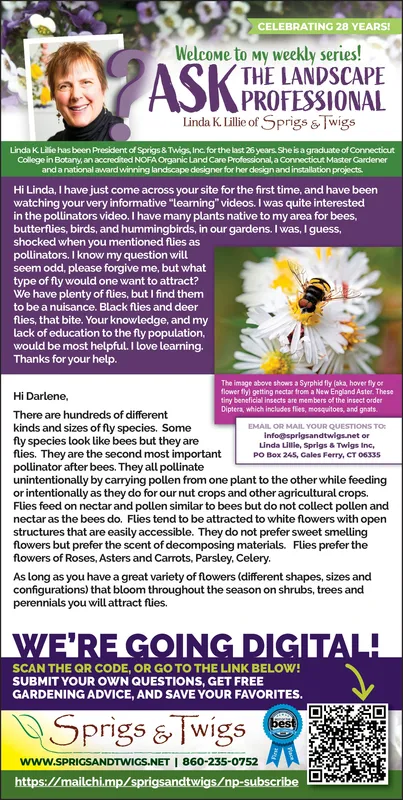Advertisement

-
Published Date
July 21, 2024This ad was originally published on this date and may contain an offer that is no longer valid. To learn more about this business and its most recent offers, click here.
Ad Text
CELEBRATING 28 YEARS! Welcome to My weekly series! THE LANDSCAPE PROFESSIONAL ASK Linda K. Lillie of Sprigs & Twigs Linda K Lillie has been President of Sprigs & Twigs, Inc. for the last 26 years. She is a graduate of Connecticut College in Botany, an accredited NOFA Organic Land Care Professional, a Connecticut Master Gardener and a national award winning landscape designer for her design and installation projects. Hi Linda, I have just come across your site for the first time, and have been watching your very informative "learning" videos. I was quite interested in the pollinators video. I have many plants native to my area for bees, butterflies, birds, and hummingbirds, in our gardens. I was, I guess, shocked when you mentioned flies as pollinators. I know my question will seem odd, please forgive me, but what type of fly would one want to attract? We have plenty of flies, but I find them to be a nuisance. Black flies and deer flies, that bite. Your knowledge, and my lack of education to the fly population, would be most helpful. I love learning. Thanks for your help. Hi Darlene, There are hundreds of different kinds and sizes of fly species. Some fly species look like bees but they are flies. They are the second most important pollinator after bees. They all pollinate The image above shows a Syrphid fly (aka, hover fly or flower fly) getting nectar from a New England Aster. These tiny beneficial insects are members of the insect order Diptera, which includes flies, mosquitoes, and gnats. EMAIL OR MAIL YOUR QUESTIONS TO: info@sprigsandtwigs.net or Linda Lillie, Sprigs & Twigs Inc, PO Box 245, Gales Ferry, CT 06335 unintentionally by carrying pollen from one plant to the other while feeding or intentionally as they do for our nut crops and other agricultural crops. Flies feed on nectar and pollen similar to bees but do not collect pollen and nectar as the bees do. Flies tend to be attracted to white flowers with open structures that are easily accessible. They do not prefer sweet smelling flowers but prefer the scent of decomposing materials. Flies prefer the flowers of Roses, Asters and Carrots, Parsley, Celery. As long as you have a great variety of flowers (different shapes, sizes and configurations) that bloom throughout the season on shrubs, trees and perennials you will attract flies. WE'RE GOING DIGITAL! SCAN THE QR CODE, OR GO TO THE LINK BELOW! SUBMIT YOUR OWN QUESTIONS, GET FREE GARDENING ADVICE, AND SAVE YOUR FAVORITES. Sprigs & Twigs WWW.SPRIGSANDTWIGS.NET | 860-235-0752 https://mailchi.mp/sprigsandtwigs/np-subscribe CELEBRATING 28 YEARS ! Welcome to My weekly series ! THE LANDSCAPE PROFESSIONAL ASK Linda K. Lillie of Sprigs & Twigs Linda K Lillie has been President of Sprigs & Twigs , Inc. for the last 26 years . She is a graduate of Connecticut College in Botany , an accredited NOFA Organic Land Care Professional , a Connecticut Master Gardener and a national award winning landscape designer for her design and installation projects . Hi Linda , I have just come across your site for the first time , and have been watching your very informative " learning " videos . I was quite interested in the pollinators video . I have many plants native to my area for bees , butterflies , birds , and hummingbirds , in our gardens . I was , I guess , shocked when you mentioned flies as pollinators . I know my question will seem odd , please forgive me , but what type of fly would one want to attract ? We have plenty of flies , but I find them to be a nuisance . Black flies and deer flies , that bite . Your knowledge , and my lack of education to the fly population , would be most helpful . I love learning . Thanks for your help . Hi Darlene , There are hundreds of different kinds and sizes of fly species . Some fly species look like bees but they are flies . They are the second most important pollinator after bees . They all pollinate The image above shows a Syrphid fly ( aka , hover fly or flower fly ) getting nectar from a New England Aster . These tiny beneficial insects are members of the insect order Diptera , which includes flies , mosquitoes , and gnats . EMAIL OR MAIL YOUR QUESTIONS TO : info@sprigsandtwigs.net or Linda Lillie , Sprigs & Twigs Inc , PO Box 245 , Gales Ferry , CT 06335 unintentionally by carrying pollen from one plant to the other while feeding or intentionally as they do for our nut crops and other agricultural crops . Flies feed on nectar and pollen similar to bees but do not collect pollen and nectar as the bees do . Flies tend to be attracted to white flowers with open structures that are easily accessible . They do not prefer sweet smelling flowers but prefer the scent of decomposing materials . Flies prefer the flowers of Roses , Asters and Carrots , Parsley , Celery . As long as you have a great variety of flowers ( different shapes , sizes and configurations ) that bloom throughout the season on shrubs , trees and perennials you will attract flies . WE'RE GOING DIGITAL ! SCAN THE QR CODE , OR GO TO THE LINK BELOW ! SUBMIT YOUR OWN QUESTIONS , GET FREE GARDENING ADVICE , AND SAVE YOUR FAVORITES . Sprigs & Twigs WWW.SPRIGSANDTWIGS.NET | 860-235-0752 https://mailchi.mp/sprigsandtwigs/np-subscribe
